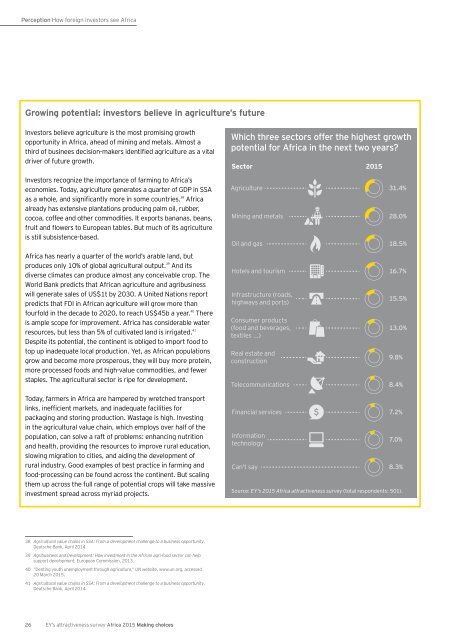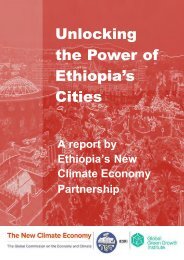EY-africa-attractiveness-survey-june-2015-final
EY-africa-attractiveness-survey-june-2015-final
EY-africa-attractiveness-survey-june-2015-final
Create successful ePaper yourself
Turn your PDF publications into a flip-book with our unique Google optimized e-Paper software.
Perception How foreign investors see AfricaGrowing potential: investors believe in agriculture’s futureInvestors believe agriculture is the most promising growthopportunity in Africa, ahead of mining and metals. Almost athird of businees decision-makers identified agriculture as a vitaldriver of future growth.Investors recognize the importance of farming to Africa’seconomies. Today, agriculture generates a quarter of GDP in SSAas a whole, and significantly more in some countries. 38 Africaalready has extensive plantations producing palm oil, rubber,cocoa, coffee and other commodities. It exports bananas, beans,fruit and flowers to European tables. But much of its agricultureis still subsistence-based.Africa has nearly a quarter of the world’s arable land, butproduces only 10% of global agricultural output. 39 And itsdiverse climates can produce almost any conceivable crop. TheWorld Bank predicts that African agriculture and agribusinesswill generate sales of US$1t by 2030. A United Nations reportpredicts that FDI in African agriculture will grow more thanfourfold in the decade to 2020, to reach US$45b a year. 40 Thereis ample scope for improvement. Africa has considerable waterresources, but less than 5% of cultivated land is irrigated. 41Despite its potential, the continent is obliged to import food totop up inadequate local production. Yet, as African populationsgrow and become more prosperous, they will buy more protein,more processed foods and high-value commodities, and fewerstaples. The agricultural sector is ripe for development.Today, farmers in Africa are hampered by wretched transportlinks, inefficient markets, and inadequate facilities forpackaging and storing production. Wastage is high. Investingin the agricultural value chain, which employs over half of thepopulation, can solve a raft of problems: enhancing nutritionand health, providing the resources to improve rural education,slowing migration to cities, and aiding the development ofrural industry. Good examples of best practice in farming andfood-processing can be found across the continent. But scalingthem up across the full range of potential crops will take massiveinvestment spread across myriad projects.Which three sectors offer the highest growthpotential for Africa in the next two years?Sector <strong>2015</strong>Agriculture 31.4%Mining and metals 28.0%Oil and gas 18.5%Hotels and tourism 16.7%Infrastructure (roads,highways and ports)Consumer products(food and beverages,textiles ...)Real estate andconstruction15.5%13.0%9.8%Telecommunications 8.4%Financial services 7.2%Informationtechnology7.0%Can't say 8.3%Source: <strong>EY</strong>'s <strong>2015</strong> Africa <strong>attractiveness</strong> <strong>survey</strong> (total respondents: 501).38 Agricultural value chains in SSA: From a development challenge to a business opportunity,Deutsche Bank, April 2014.39 Agribusiness and Development: How investment in the African agri-food sector can helpsupport development, European Commission, 2013.40 “Denting youth unemployment through agriculture,” UN website, www.un.org, accessed20 March <strong>2015</strong>.41 Agricultural value chains in SSA: From a development challenge to a business opportunity,Deutsche Bank, April 2014.26 <strong>EY</strong>’s <strong>attractiveness</strong> <strong>survey</strong> Africa <strong>2015</strong> Making choices



